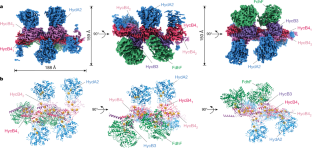2022-07-20 ドイツ連邦共和国・ゲーテ大学フランクフルト・アム・マイン(フランクフルト大学)

・ フランクフルト大学、マールブルク大学およびスイス・バーゼル大学が、深海等に生息する嫌気性の Thermoanaerobacter kivui の酵素である水素依存性二酸化炭素リダクターゼ(HDCR)について、その構造を原子レベルで初めて解明。
・ 2013 年にフランクフルト大学が発見した HDCR は、水素と CO2 を直接利用して(水素が CO2 に電子を送り)ギ酸を生産する。ギ酸を生産する他の酵素では、電子の移動は電子移動物質を介して間接的に行われる。
・ HDCR は、水素の分割、ギ酸の生産、鉄-硫黄を含む 2 つの小モジュールの 4 つのタンパク質モジュールより構成され、2 つの小モジュールが各モジュール間の電子移動に関与している。
・ 2016 年には HDCR が長いフィラメントを形成することを発見。フィラメント形成は酵素の活性を著しく促進することから、同構造の重要性を認識した。
・ 本研究では、クライオ電子顕微鏡法による解析を通じて、原子レベルの分解能で HDCR の構造を解明。研究室での実験条件下にて、酵素が形成する長いフィラメントの詳細を可視化した。
・ その結果、フィラメントは 2 つの HDCR サブユニットから構成され、それらのサブユニットは電子伝送の役割を担う数千個もの鉄原子を持つナノワイヤを形成するように配置されていることを確認。これまでに発見されたナノワイヤで唯一酵素を備えているもので、ナノワイヤ上にはヒドロゲナーゼモジュールとギ酸のデヒドロゲナーゼモジュールが配置される。
・ 酵素モノマーは細菌の細胞内でもフィラメント構造に自己組織化し、数百本ものフィラメントが束になって環状の上部構造を形成することを確認。「有機的な液体水素キャリア」として水素と CO2 からギ酸を生産する HDCR の、化学触媒や他の酵素を大幅に超える効率性を裏付ける。
・ ナノワイヤによる電子の貯蔵、フィラメント形成による酵素活性の強力な促進や、フィラメント束の内膜への固定状態等、HDCR のさらなる解明について研究を進める。バイオロジカルな水素貯蔵手段実現への一歩であり、大気中の CO2 の捕獲に利用できる合成ナノワイヤの製造等、HDCR の可能性を期待。
URL: https://aktuelles.uni-frankfurt.de/englisch/research-on-bacteria-electron-highway-for-hydrogen-and-carbon-dioxide-storage-discovered/
関連情報
Nature 掲載論文(アブストラクトのみ:全文は有料)
Membrane-anchored HDCR nanowires drive hydrogen-powered CO2 fixation
URL: https://www.nature.com/articles/s41586-022-04971-z
Abstract
Filamentous enzymes have been found in all domains of life, but the advantage of filamentation is often elusive1. Some anaerobic, autotrophic bacteria have an unusual filamentous enzyme for CO2 fixation—hydrogen-dependent CO2 reductase (HDCR)2,3—which directly converts H2 and CO2 into formic acid. HDCR reduces CO2 with a higher activity than any other known biological or chemical catalyst4,5, and it has therefore gained considerable interest in two areas of global relevance: hydrogen storage and combating climate change by capturing atmospheric CO2. However, the mechanistic basis of the high catalytic turnover rate of HDCR has remained unknown. Here we use cryo-electron microscopy to reveal the structure of a short HDCR filament from the acetogenic bacterium Thermoanaerobacter kivui. The minimum repeating unit is a hexamer that consists of a formate dehydrogenase (FdhF) and two hydrogenases (HydA2) bound around a central core of hydrogenase Fe-S subunits, one HycB3 and two HycB4. These small bacterial polyferredoxin-like proteins oligomerize through their C-terminal helices to form the backbone of the filament. By combining structure-directed mutagenesis with enzymatic analysis, we show that filamentation and rapid electron transfer through the filament enhance the activity of HDCR. To investigate the structure of HDCR in situ, we imaged T. kivui cells with cryo-electron tomography and found that HDCR filaments bundle into large ring-shaped superstructures attached to the plasma membrane. This supramolecular organization may further enhance the stability and connectivity of HDCR to form a specialized metabolic subcompartment within the cell.



